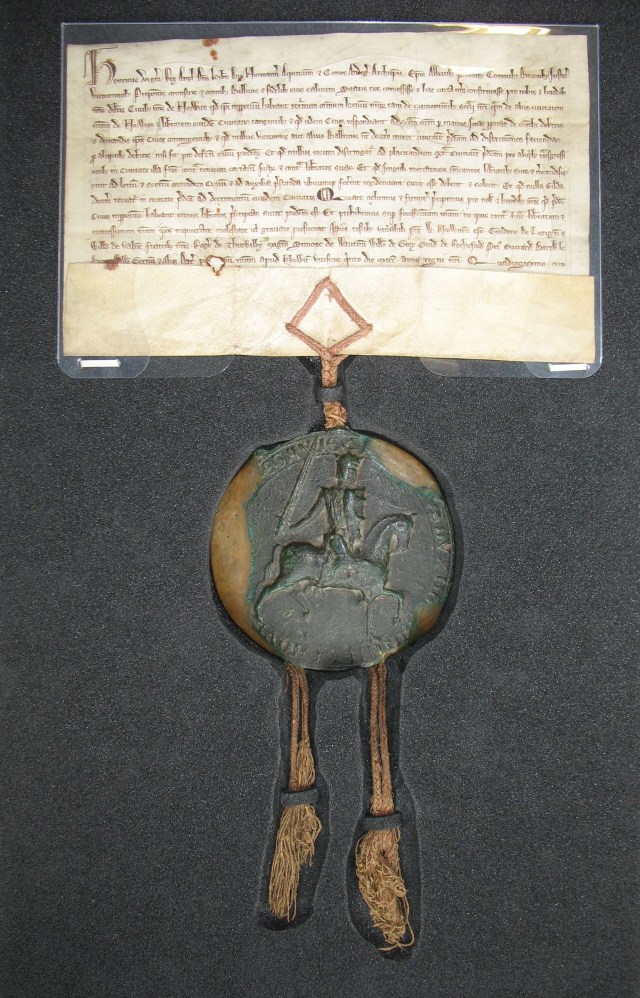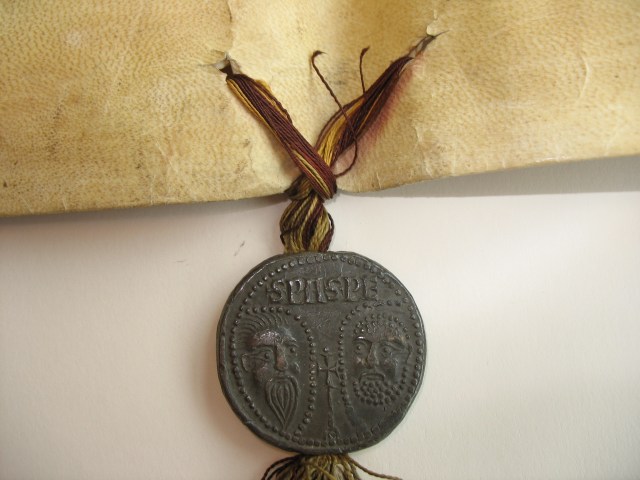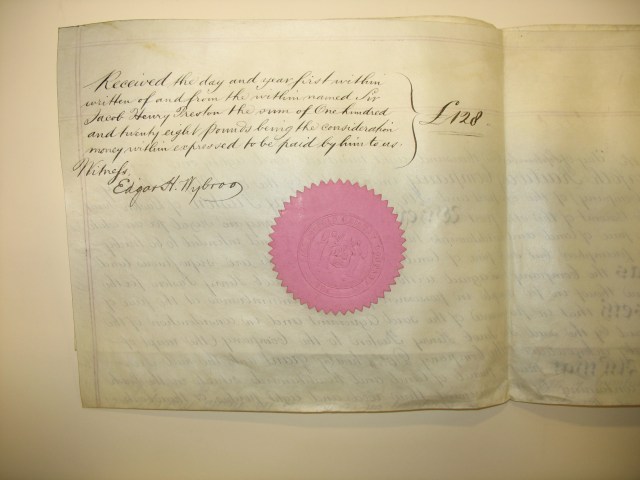Many visitors to the Norfolk Record Office will have come across seals on documents, through requesting records to the searchroom, on display in behind-the-scenes tours or waiting in conservation for our kind team of volunteers who sew socks to fit!
The Norfolk Record Office has many examples of seals of all kinds and some of the main types of seal and methods of affixing them to documents are shown in the examples below.
The Use of Seals
From earliest times, seals were used to authenticate documents or to close them in order to keep their contents private, or for both these reasons.
The seals used in England after the Norman Conquest were of three main shapes: round, oval, or the pointed oval known as a vesica. Vesica seals were often (though not exclusively) used by ecclesiastics and women.
Although the small, round papal seals known as bullae were of lead, English medieval seals were usually made from beeswax, which could be either natural or coloured, using pigments such as vermillion for red, verdigris for green, or orpiment for yellow. From the late sixteenth century onwards, shellac was also used for seals.
Methods of Attachment
There were several methods of attaching seals to documents, which are traditionally described using French terms.
Seals could be applied to the face of the document (en placard or plaqué) or could be hung from it as a pendant seal.
Pendant seals were attached either from parchment tags or by cords or laces. The simplest method of making a tag was to cut part of the way along the bottom edge of the document, so as to make an attached strip to which the seal could be affixed. This method is called sur simple queue (‘on a simple tail’). The problem with this method was that the weight of the seal could often tear the tag away from the document.
Since it was extremely important that the seal should not be easily removed, a better method known as sur double queue (‘on a double tail’) was devised. This was done by folding up the bottom edge of a document, cutting horizontal slits in it, then passing through the slits a double strip of parchment, to which the seal was attached.
A refinement of this method was to thread woven cords or laces, often of silk, through slits or holes in the bottom edge of the document.
The Process of Sealing: the Matrix or Die
The process of sealing meant impressing a die or matrix into wax, or, from the seventeenth century, shellac. The matrix was usually made of metal, skilfully engraved (often by silversmiths), although, sometimes, non-metallic materials, such as stone or gemstones, were used. The centre of seal impressions could bear a huge variety of images, such as castles or ships for towns, saints or churches for monasteries, and military figures or armorial bearings for knights. Around the edge, there was often a border containing a legend. Pendant seals, such as the royal Great Seal, could be double-sided.
This seal (ABOVE LEFT) is the obverse of the double matrix of the second conventual seal of Norwich Cathedral Priory, in use from 1258. Measuring 8 cm in diameter, it is made of latten (a copper alloy, much like brass) and is engraved in the finest detail. At the top and bottom are lugs which enable this part of the matrix to be properly aligned with the reverse part.
The seal depicts an ecclesiastical building, with the full-length figure of bishop Herbert de Losinga in the centre. In niches on either side of him are the mitred heads of six other bishops, three on each side, while above are two angels with censers descending from heaven. Around the edge, the lettering, reads: SIGILLUM : ECCLESI[E SAN]CTE :TRINI[TATIS] : NORWICI [‘the seal of the church of the Holy Trinity, Norwich’].
On the right is a double-sided seal from red wax, impressed from the seal matrix on the left. It has been removed from the document to which it is related by cutting the seal tag. In the eighteenth and nineteenth centuries, removing seals from documents for separate storage was, unfortunately, a common practice.
Pendant Seal, sur simple queue

Power of attorney from Thomas Balle of Flicham to William de Irmynglond, 27 January 1387. NRO: FLT 2/200
This document is a power of attorney from Thomas Balle of Flicham to William de Irmynglond, 27 January 1387. The Balle or Ball family were minor manorial lords who held lands in Flitcham, Appleton and Anmer.
In this example Thomas Balle’s small, circular armorial seal in red wax, measuring 2.3 cm, is attached to a parchment tag, sur simple queue. The tag is simply cut from the bottom edge of the document.
Pendant Seal, sur double queue

An indenture by which Robert de Mortuomar, knight, grants land to Richard Neytenyn and his wife, Joan. 4 February 1361. NRO: PTR 1/45, 756X5
This document is an indenture by which Robert de Mortuomar, knight, grants land to Richard Neytenyn and his wife, Joan. 4 February 1361.
The small, circular armorial seal of Sir Robert de Mortuomar, in red wax, depends from a parchment tag, sur double queue. The tag is wrapped above the seal with strands of flax, as a means of protection. The seal measures 2.6 cm by 3 cm at its widest points.
Pendant Seal, hung from Cords

Royal charter from Henry III to the citizens of Norwich. Dated at Norwich, 25 March, 40 Henry III. NRO: NCR Case 26a/6a
The first version of Henry III’s Great Seal, in green wax, measuring 10.5 cm, hangs from the document on braided cords. These have a pinkish and brown appearance, but may have originally have been of red and green. The cords are attached to the document by threading them through four holes made in the turned up bottom edge.
As with all English royal Great Seals, this seal is doublesided. This side depicts the king on horseback, riding to the right. He wears a surcoat over a hauberk of mail, and a helm surmounted by an open crown of three points. In his right hand, he bears a sword and, in his left, suspended from an embroidered strap, a shield with the arms of England. The other side shows the king in majesty, seated on a throne.
The seal has been repaired as it was partially damaged around the edges, this can be seen through the areas of uncoloured, plain beeswax which show where conservation work has taken place.
Multiple Pendant Seals, sur double queue

Charter issued to settle a dispute, 20 May 1412. King’s Lynn Borough Archives, NRO: KL/C 4/8
The document has fifty-eight small seals on eight long tags, sur double queue, with each tag bearing multiple seals.
Types of seal and methods of protecting them
Lead Bulla

Lead bulla appended to letters (‘papal bull’) of Pope Alexander IV, confirming to the abbey of St Benet at Holme the patronage of the churches of Bastwick, Irstead and Neatishead. 9 March 1257. NRO: DN/EST 6/2
In Roman Catholicism, the metal seals attached to official papal letters or documents are known as bulla. Usually made of lead, on rare occasions these seals might be covered in gold- the so-called ‘golden bull’.
The seal depicts the founders of the Roman church, the apostles, Peter and Paul. The name of Alexander IV, as the issuing pope is on the reverse side. The bulla is attached to the document by cords of red and yellow silk, looped through holes in the folded up bottom edge.
Pendant Seal in a protective Skippet

The seal of George IV, 1828, from natural, uncoloured beeswax. In the centre, it depicts the king, crowned and holding sceptre and orb, seated in St Edward’s Chair surrounded by personifications of Ireland, Scotland, Britain, Justice, Religion and Minerva. NRO: DCN 31/2
By their very nature, seals are relatively fragile, so, over the centuries, many means of protecting them were devised. One method, popular in the nineteenth century, especially in the royal Chancery, involved enclosing the seal within a metal container called a ‘skippet,’ at the time of sealing. Skippets were often made of tinplate, brass, or, as in the example above, galvanized steel. Although metal skippets protect wax seals from knocks, once the lid is placed on the skippet, it can cause the seal to dry out over a period of years. However, the seal shown above, which was given the added protection of a coat of varnish, has not suffered in this way.
Paper Seal Wafer, en placard, embossed directly through the Face of the Document

The Common Seal of the East Norfolk Railway Company, affixed to the face of a receipt for £128 from Sir Jacob Henry Preston, 14 September 1881. NRO: MC 36/203
By the nineteenth century, it had become a common practice in sealing to affix to the face of documents adhesive, coloured paper wafers, through which the impression of a seal could be imprinted, using a embossing machine or press. The earliest known seal press designed to emboss a seal on to paper rather than wax was made in 1782, although in all likelihood this was not the first.
The seal on this document is embossed on to a pink, circular wafer, measuring 6.8 cm in radius. In the centre of the design is a shield bearing the arms of Norwich, supported on either side by an angel, each carrying a sword.
This text has been adapted from the Exhibition Guide ‘Seals and sealing’ held at the Norfolk Record Office from December 2007-March 2008.


















would like to send some photos of medieval parchment with wood seals.
LikeLike
Hi Andrew, we would be interested to see your examples of wood seals. Could you please send them to norfrec@norfolk.gov.uk with FAO: Education and Outreach in the subject bar.
LikeLike
Good blog post. I definitely love this site. Keep writing!
LikeLike
Evening
I have a seal that I’m trying to identify, where would you suggest I go for advice?
regards
Andrew
LikeLike
Hi Andrew, a really good starting point would be to try http://www.digisig.org/. Hope that helps.
LikeLike
Pingback: History, Use, and Study of Seals - Birgitte Breemerkamp